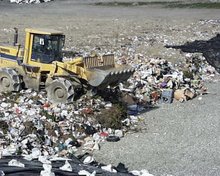
In late 2003, I began publishing online a work of fiction about a murder in a small sleepy Alabama community. Later I published the same work in print form. One subplot focused on a fictional landfill that posed a danger to Crawfordville, my fictional community. The controversy over Conecuh Woods and the alleged leakage in the Timberlands landfill was still in the future when I wrote "The Publisher." This is the introduction to Chapter Nine:
Crawfordville, Alabama – the present
The landfill was located in the northeastern portion of Big Creek County. It covered just less than 300 acres. The popular former state executive who owned the landfill had seen to it, prior to leaving office that the Big Creek County Environmental Corporation got every break it legally could in the permitting process. Consequently, the Big Creek County Landfill had the largest daily tonnage capacity of any of the thirty state permitted landfills in Alabama. 2500 tons a day of solid waste doesn’t seem like much until you convert the figure to 5,000,000 pounds per day extended to 1,800,000,000 pounds per year. Given that Big Creek County had a population of only 30, 000 that figured out to 167 pounds of trash per day per resident of the county.
Big Creek County Environmental Corporation would bankrupt itself if it had to depend on Big Creek County and its various municipalities to supply 2500 tons of trash per day, so various arrangements and contracts had been made with 24 other Alabama counties; 4 counties in Florida, and 8 counties in Mississippi and Texas to make up the difference. Eighteen wheelers rolled to the Big Creek Landfill from all directions. Trash from Pensacola, Mobile, Montgomery, Houston and even trash from the casinos in Biloxi and Gulfport made its way to Crawfordville on a daily basis. From five miles in all directions the rich soured scent of the landfill was present and pervasive. Highway damage and increased levels of spilled trash on the right-of -way had become a problem. The quality of personnel manning the landfill was a much bigger problem, however, than spilled trash...
The landfill was self-monitored. Ideally each truck carrying solid waste into the fill was inspected and weighed with any illegal waste being turned away. Prohibited hazardous waste and medical wastes made their way into the Big Creek County Landfill for an "under the table" fee. Once a local environmental activist complained and she was hounded out of town for being a "nutcase". The politicized Environmental Protection Agency was called in to investigate, but would not release their findings until a Montgomery based environmental watchdog group sued. The EPA investigation was summed up as, Question: "Did you fellows break the law?" Answer: "No we didn't break any laws." EPA response: "Well that sounds good enough for us, sorry to bother you." The EPA declared the case closed without ever testing the landfill, performing any stakeouts or surveillance, nor conducting any type of investigation.
Meanwhile, in the landfill itself, a concoction of toxic chemicals, organics, and trace metals had conglomerated themselves into a mixture known as a plume that was seeping towards an unexpected crack in the low permeable liner of the landfill. Below the liner was the water table. Crawfordville was downstream and eleven miles away....
Click here for purchase information on The Publisher



No comments:
Post a Comment